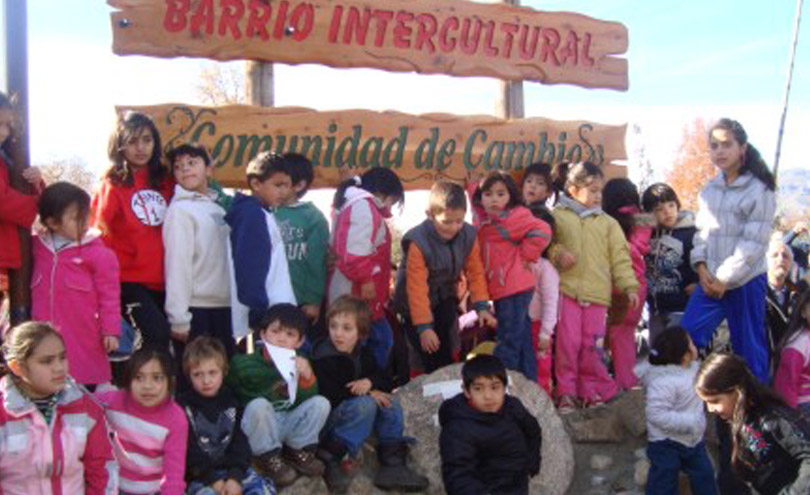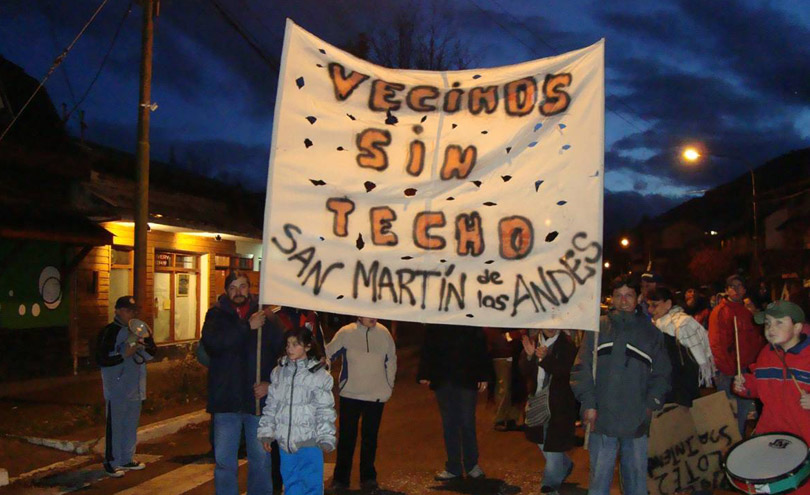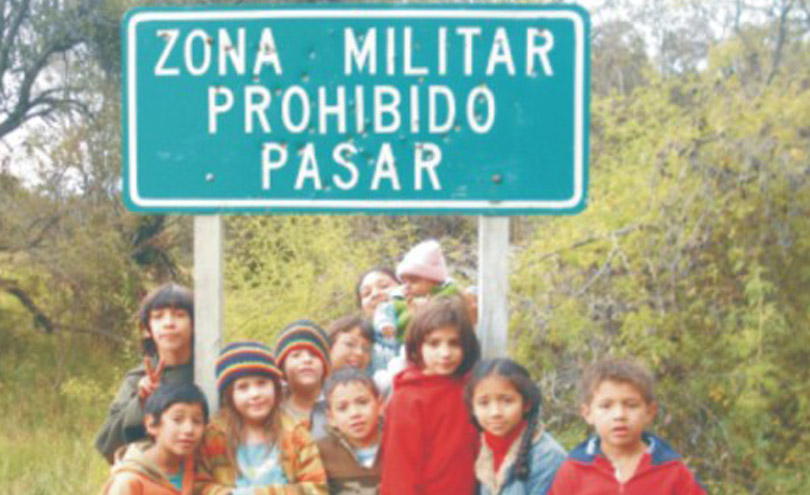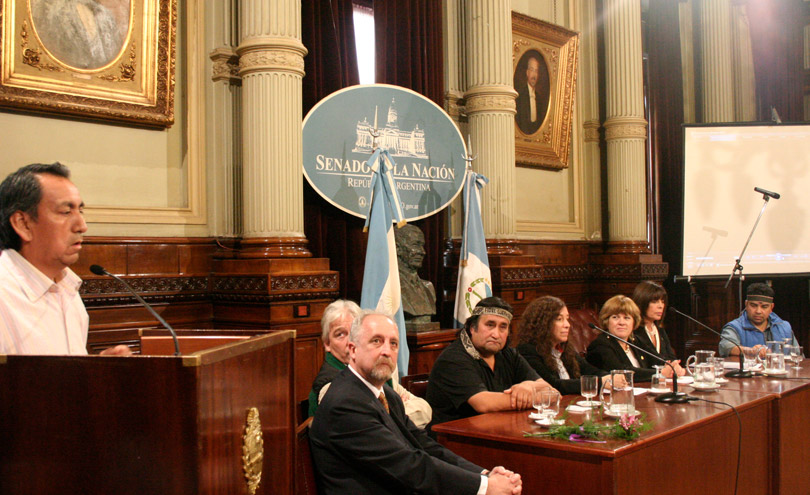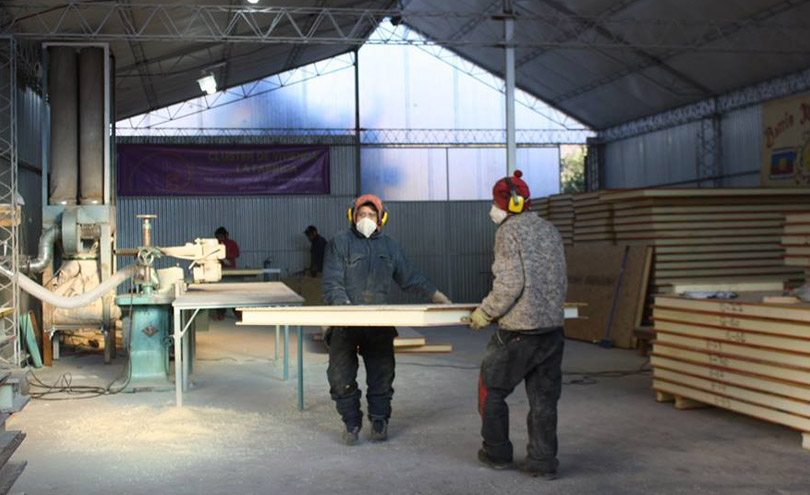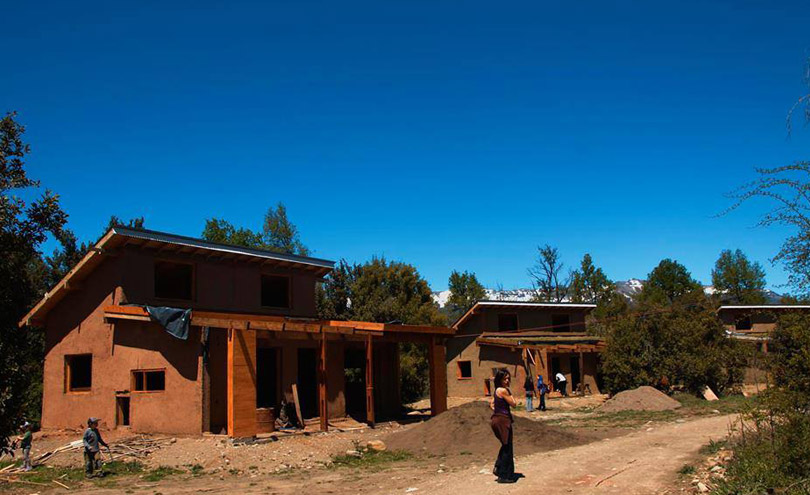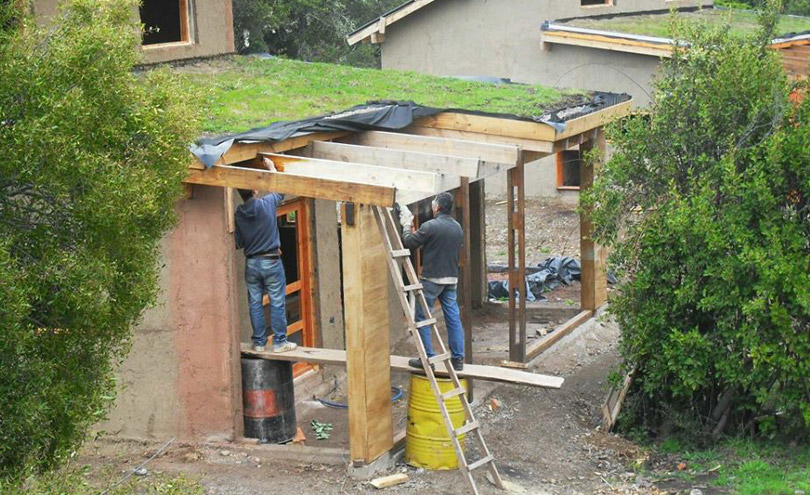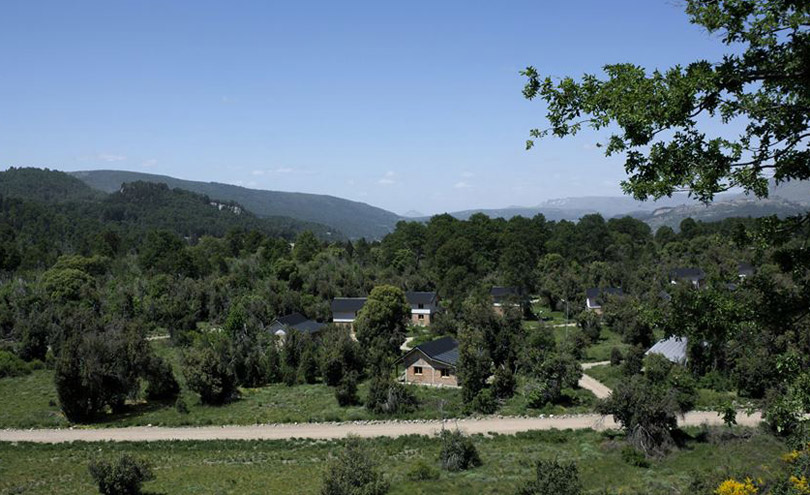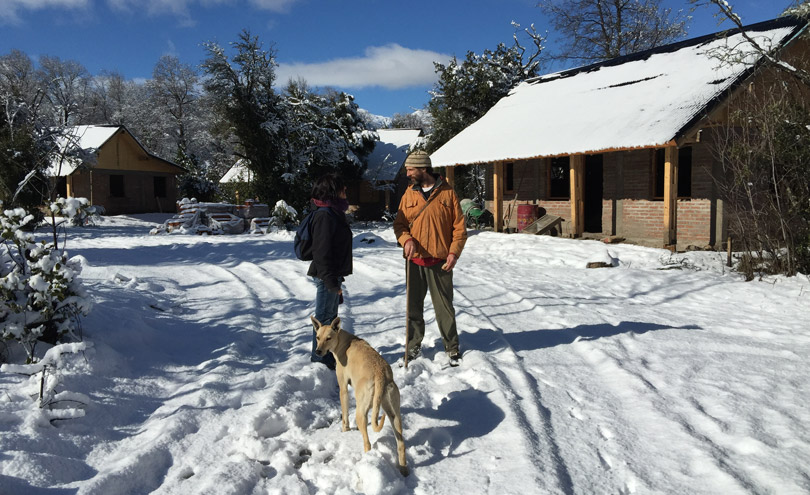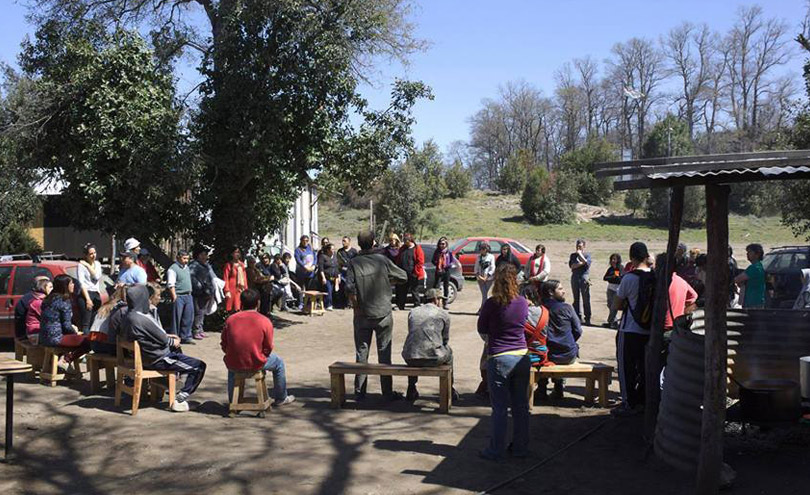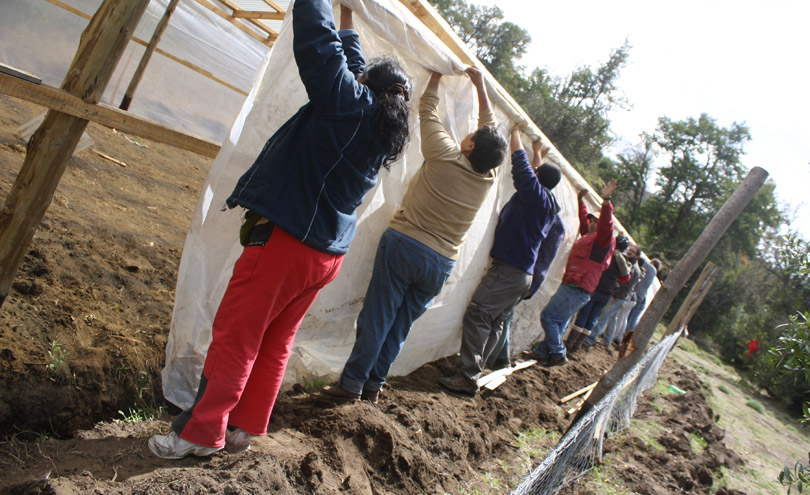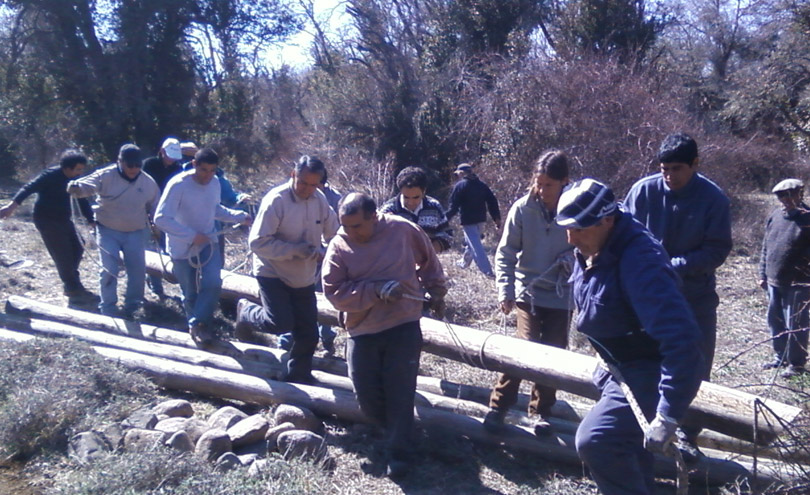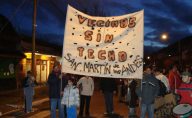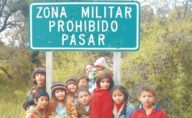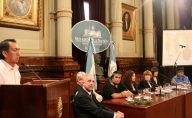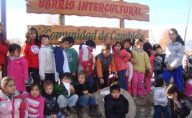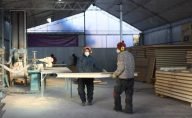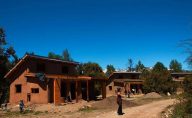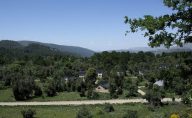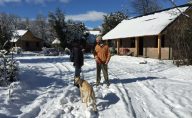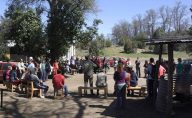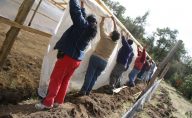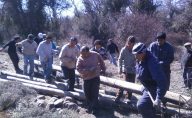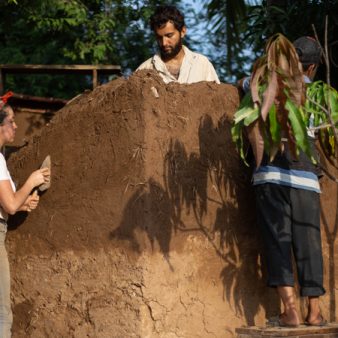Project Description
The Intercultural Neighbourhood is within an area of land of approximately 400 hectares known as Plot 27. It is three kilometres from the centre of the city of San Martin de los Andes in Argentina. The owners of the land were the indigenous Mapuche Curruhuinca community but the land had been occupied by the Argentinian military. The Curruhuinca community started a proposal for the restitution of their land in 2004. They achieved success in 2011 when a law was passed by the National Government handing back ownership to the Curruhuinca community (National Law 26.725).
The partnership between the Curruhuinca community and Vecinos Sin Techo has focused on developing a joint response to the housing crisis by planning and driving the development of legislation and resources that support the urbanisation of the area.
The environmentally sustainable Intercultural Neighbourhood created is an approach to providing decent and peaceful communal living. It has gone through several stages in order to achieve this aim:
- starting from the recognition of the community’s ancestral right to the territory and respecting cultural and environmental diversity;
- delivering urbanisation on community-owned land;
- striving for sustainability in terms of food and energy production, use and management through appropriate technologies.
Of the approximately 400 hectares, almost 300 are used by the Mapuche community and 110 are distributed as follows: 77 for the Intercultural Neighbourhood and 33 for the local authority.
Since 2014, 56 houses have been built and another 100 are currently under construction. About 200 local people have been allocated the first 56 houses, of which 20 are now inhabited and housing is planned for another 1,000 people who will live in the neighbourhood.
By the end of 2017, 156 houses will be finished and the training and management structure will be in place to complete a total of 250 by the end of Stage 1. The time schedule for a second stage is not yet in place.
Aims and Objectives
The aim of the project is to achieve better political, legal and social conditions which comply with people’s right to access land and housing, and to ensure the respect of cultural diversity and different approaches to the environment.
The focus is on developing housing and intercultural communal living between the indigenous Mapuche community and impoverished creole communities who are excluded from the housing market. It aims to develop a local and regional development model that drives a project for peace. The context for the need for peace is a response to the relationship between the State and indigenous communities, which historically was based on domination and the denial of the identity of these communities.
The project aims to achieve access to a decent home for marginalised communities and the working class of the city, who are unable to access home ownership. It seeks to do this by:
- Restitution of Plot 27 to the Mapuche Curruhuinca community which was achieved by the historic recognition of the legitimate right of this native community to their ancestral land. It had been used by the Argentinian Army for the last 130 years ago.
- Construction of a decent habitat for 250 families through the creation of the Intercultural Neighbourhood, conceived as a ‘Community for Change’. This neighbourhood would promote socially and environmentally sustainable development by providing access to a decent home by working together (mutual aid), individual efforts and the establishment of intercultural relationships.
The Intercultural Neighbourhood is developed as a comprehensive and sustainable demonstration project. The objective of its participatory design is integration of the following dimensions: Neighbourhood, Housing, Appropriate Technologies, Social Economy, Health, Education and Culture.
The 2004 census conducted by Vecinos Sin Techo identified that there were 2,500 families in housing need in the local area. In terms of the number of people involved, 250 families participate directly in the Intercultural Neighbourhood as current or forthcoming residents. Another 750 families have registered for the second stage.
Context
Four communities of the Mapuche Nation live around San Martin de los Andes. The Mapuche are the original inhabitants and have lived in Patagonia for thousands of years. The territory where the project is located was taken over in the late 19th Century by the Argentine and Chilean States during their respective military campaigns. Since then, the rights of the Mapuche Nation have been neglected.
The current housing market has led to a situation in which 20% of the local population lacks access to home ownership, and renters are faced with high prices. Many people share their homes with other families, live in poor quality housing or in situations of overcrowding, which is detrimental to family life. The State’s housing policies made it more difficult for communities to access good quality land. Higher quality land was allocated for market priced housing, and only marginal land was allocated for social housing. The Mapuche community consider that this increased the population of informal settlements in high-risk areas, i.e. prone to landslides and flooding.
The census conducted by Vecinos Sin Techo in 2004 demonstrated that 20% of the population were in housing need and this forced the local authority to make their first declaration of a Housing Emergency. This has led to an increased allocation of resources for housing and the creation of emergency intervention plans on a rights-based approach and thereby increased the provision of housing in a shorter period of time than normal.
Key Features
This community-led programme takes both an inward and outward looking approach:
Organisational principles and strategies:
The organisation of the group follows democratic and participatory principles with weekly meetings. Assembly meetings take place in spaces where all the actions of the organisation are shared and key strategies defined and agreed.
Vecinos Sin Techo is made up of a Board of Directors and members but the positions do not represent a hierarchy as the structure is horizontal and decisions are made by consensus.
The organisation recognises the territorial rights of the Mapuche and their fight for the need for decent housing is shared across the whole community.
By developing a consensus approach and by identifying key people within the community, the programme has been able to influence public housing policy in a way that has genuinely involved local people. Communities have been involved in the design stages and also in the construction of housing and other facilities in the neighbourhood including a workshop and community room, a greenhouse and vegetable garden etc.
A community-led cluster was set up to address sustainability issues. The cluster suggests a number of options for habitat production, developing a social enterprise (supported by and with the involvement of businesses, government and academic stakeholders). The most important alliance is with working class people and their organisations and the process has already facilitated the creation of housing and infrastructure, along with a number of cooperative enterprises in construction, food, culture, health, inter-culturalism, education, etc., and the supply of energy and water.
An intercultural health project was designed by an interdisciplinary team that includes three professionals from the public health system, Mapuche residents with knowledge of traditional medicine, and organisations, such as the Jarilla Network, which works on plants that improve health. This promotes a way of thinking about health that is not only about ‘healing’ but has an emphasis on health promotion: healthy food, products (such as soap), pregnancy and childbirth etc.
Externally focused strategies for systemic change:
Vecinos Sin Techo also has an externally-focused strategy which aims to position the organisation as a key player in discussions with public and finance institutions in order to transform habitat-related policies. This is achieved by building alliances, advocacy, negotiation and participation which are progressively established with the Mapuche community, local authority, the Federal State, universities and other organisations with a social purpose.
Spaces for public debate, reflection, capacity building and negotiation with public authorities have been opened up by Vecinos Sin Techo. General awareness-raising has taken place through workshops, media activities, cultural and academic events, seminars, scientific papers and many other ways of participation with a view to changing people’s understanding of the problem and finding ways to resolve it.
The relationships with different municipal, provincial and national governments vary according to the political party in power, however, the Intercultural Neighbourhood is already a political force in its own right and is recognised by the local authority and at a national level.
The programme works with a wide range of partner organisations, each contributing their area of knowledge and expertise:
- Mapuche confederation of Neuquen province (territorial recovery).
- Mapuche Curruhuinca community (founding member of the project).
- Jarilla Network of Healthy Plants of Patagonia (health-related knowledge).
- FM Pocahullo Community Radio (internal management and dissemination).
- Propatagonia CSO (capacity building and technical assistance).
- Renters and Squatters Movement (collaboration in internal management, cross-sectoral management, self-management etc.).
- Popular Economy Workers Confederation (dissemination and strategic political alliance and capacity building).
- Andean Apiculture Cooperative (technical assistance and capacity building) and Estefani Cooperative (construction material).
- HIC members (Habitat International Coalition), participation in the Social Production of Habitat Group (strategy exchange, alliances and international cooperation for the project’s management and visibility).
Government Institutions:
- Honourable Congress of the Argentine Nation (enactment of the law of territorial restitution).
- National Executive (providing finance for the programme).
- National Institute for Industrial Technology (capacity building and technical cooperation).
- Provincial School for Technical Education N°21 (cooperation and technical assistance, strategic political alliance).
- Architecture School at La Plata National University (outreach projects, technical assistance).
- Comahue National University (outreach and cooperation project).
- Cordoba National University (Collaborative project for assessment and technical assistance).
- Provincial Management for Aquatic Biology (technical assistance).
- National Institute for Agriculture and Farming Technology (technical assistance).
What impact has it had?
The advocacy work of Vecinos Sin Techo has had a direct impact on policy and practice in a variety of ways:
- Development of the Unified Registry for Housing Demand, which is a formal record of housing need in the local authority area. Knowing more about local people’s housing need has already led to changes in local housing policy.
- Creation of the municipal Housing and Habitat Institute with a team from Vecinos Sin Techo. The Institute is a dedicated team within the local authority and is in charge of housing policies, previously dealt with at a much smaller scale. It works hand-in-hand with Vecinos Sin Techo.
- Vecinos Sin Techo’s advocacy work and its collaboration with the Housing and Habitat Institute has led to the development of housing and land acquisition plans; criteria based on participation and transparent mechanisms for housing allocation; regulations for self-management, urban surplus and adobe construction.
The development of a mechanism for housing allocation based on participatory criteria ended the trend of selective allocation which favoured those close to government. Since 2005, successes have included:
- 50 new houses developed under the ‘most urgent home’ programme (government social housing).
- Relocation of 26 families living in hazardous areas in Colonia Maipu to safer areas.
- 200 new houses provided between 2007 and 2011(social housing).
- 120 houses achieved between 2008 and 2010 (social housing).
The Intercultural Neighbourhood is a sustainable example of how to solve wide-scale housing problems and demonstrates how community access to land can deliver integrated housing solutions for low-income communities. Through its networks and wider dissemination the programme has the potential to act as an example of good practice at local, regional and national level as well as across Latin America.
How is it funded?
The following state resources have been secured by Vecinos Sin Techo themselves or through strategic partnerships[1]:
- 2010: Argentine Pesos (ARS) 48,000 (USD $3,000) in equipment – Ministry of Social Development.
- 2011-12: Inter-disciplinary Technical Team, Intercultural Neighbourhood participatory design, ARS 980,000 (USD $65,000), Pre-Investment National Unit, Ministry of Economy.
- 2012: Food and agriculture, greenhouses, tools, irrigation and solar panels, ARS 55,000 (USD $4,000), Ministry of Social Development
- 2013-14: Award in III Provincial Competition for Social Projects 2013, Separating Dry Toilet, Russian and SARA Stoves, ARS 30,000 (USD $2,000), Neuquen Province.
- 2014-15: Infrastructure and Machinery for wood and metal joinery, ARS 500,000 (USD $33,000) Ministry of Labour.
- 2014-16: “56 Houses”, ARS 17 million (USD $1.1 million) + ARS 4 million (USD $264,000), Federal Programme for Native and Rural Communities, Sub-Secretary of Housing, Ministry of Planning and Public Works.
- 2015-16: “100 Houses and Infrastructure”, ARS 60 million (USD $4 million), Federal Programme for Native and Rural Communities, Sub-Secretary of Housing, Ministry of Interior.
- 2016: SARA Stove ARS 70,000 (USD $5,000), Ministry of Science and Technology.
- 2016: Inter-disciplinary Technical Team, Urban Design Executive Projects, ARS 834,000 (USD $55,000), Ministry of Interior.
The cumulative costs for Phase 1 were: ARS 23 million (USD $1.5 million).
The annual costs of the operation of the project were financed by the above mentioned subsidies.
A progressive and evolving self-management and comprehensive development process is planned and executed. The organisation expects to continue managing state resources that they are entitled to, and at the same time through the development of the social economy, self-build and mutual aid projects, guarantee that it can move forward even in periods of political difficulty.
Since its foundation in 2004, Vecinos Sin Techo has covered its costs by organising fundraising events and since its formal constitution as a non-profit organisation in 2008, it has received a symbolic monetary contribution from its members of between ARS 2 – 10 (USD $1 – USD $2).
Since the end of 2015, Vecinos Sin Techo has collected a monthly contribution of ARS 100 (USD $7) per family, generating an approximate income of ARS 12,000 (USD $800) per month, which is used to buy supplies for the community infrastructure of the Intercultural Neighbourhood, as well as covering the running costs of the organisation. These running costs have totalled ARS 50,000 (USD $3,000) per year in the last two years and have increased to around ARS 100,000 (USD $7,000) each year due to higher costs and inflation.
The first 56 houses cost an average of ARS 360,000 (USD $24,000), and in the current construction plan they are estimated at ARS 500,000 (USD $33,000). However, a nearby social housing development by the State has budgeted each house at a cost of ARS 1 million (USD $66,000) each. This reflects the impact of inflation and therefore the need to adjust projections and subsidies accordingly.
[1] Exchange rates between Argentinian Peso and US Dollar have varied significantly between 2010 USD $1 = ARS 3.9) and 2016 (USD $1 = ARS 15+); the USD figures indicated above reflect the exchange rate of their respective years
Why is it innovative?
The Intercultural Neighbourhood offers a comprehensive vision of habitat and respectful communal living, establishing a cultural exchange between the native Mapuche community and working-class communities. This not only contributes to the restitution of their territory and rights but also presents an opportunity for peaceful and decent communal living for future generations in a community free from the risk of land speculation.
Beyond just being an accessible housing project, the Neighbourhood is a productive place with agriculture projects supporting food security and programmes to develop the use of renewable energy as well as recreational activities for residents and the general community.
What is the environmental impact?
The programme is specifically designed to respect the environment and to keep half of the land free of urbanisation. It was agreed not to cut down trees for construction works, identifying and valuing the native species for their use in natural medicine, as a source of food and as part of the identity of the region.
An environmental survey conducted involving Mapuche and non-Mapuche people highlighted the different ways cultures interact with nature and also had a significant influence on the design of the housing, for example, the orientation of the houses, insulation of walls and joints, energy efficient lighting, grey water reuse, absorption systems for black water, comprehensive waste management system, compost production, etc.).
Housing construction using adobe and living roofs were added to traditional construction systems, setting a precedent in the use of public funds for social housing.
With firewood being the main resource for heating in the local area, the project looked to develop a high performance stove accessible to all families, which was built in adobe and which optimises the use of firewood. Other developments using alternative materials and eco-technologies have included dry toilets, solar collectors and hydroelectric power, which are being experimentally developed in a Renewable Energy class in the National Institute for Industrial Technology and the Provincial School for Technical Learning.
In the design of the neighbourhood, roads for vehicles have been minimised, prioritising cycle and pedestrian paths.
Community meeting spaces have been defined, as well as establishing a Mapuche (Rewe) ritual-ceremonial site.
Food and agriculture production is organic, avoiding the use of agro-chemicals. The first honey harvest was carried out with the Apiculture Cooperative and there are plans to grow the apiary and its production year on year.
Is it financially sustainable?
The programme relies on public funds from local and federal government to support the construction of the housing. However, it is moving towards a social economy model which aims to generate income from a variety of activities.
All Vecinos Sin Techo members (whether they are Neighbourhood residents or not) pay a monthly contribution, currently ARS 100 (USD $7) per month. Residents and members undertake community work and participate in assemblies, although they only pay the contribution fee if they become Vecinos Sin Techo members. There is no specific mechanism to organise sweat equity but housing allocation is undertaken in assemblies and priority is given to the most active members.
The programme is looking to develop a social enterprise approach to food and energy efficiency within the community as a collaborative approach to income generation and sustainability.
What is the social impact?
The project is fundamentally based on respect for the Mapuche cultural identity:
- it promotes equal rights;
- provides an innovative and comprehensive habitat solution in central, high value land;
- restores dignity for those involved in the project;
- contributes to social harmony and peace in the city;
- builds a process of collective identity and mutual respect through intercultural activities.
The project involves both Vecinos Sin Techo and the Mapuche Curruhuinca community collectively in a celebration of different cultures and intercultural living. The local authority has revised their Charter and has declared itself an ‘Intercultural Municipality’, with the Mapuche flag currently raised in the city’s main square. The Intercultural Neighbourhood has played a fundamental part in changing attitudes within the communities and public institutions alike.
The Intercultural Neighbourhood is situated next to the most expensive areas of the city. It has managed to build quality housing, which is a surprise to those who expect to see ‘typical social housing’ and has succeeded in achieving the ‘right to beauty in design’. Traditional social housing is uniform, small and often inadequate for residents. The design of the housing in the Neighbourhood is a result of residents’ input and reflects a diversity of choices. The houses are comparatively spacious and designed to respond to residents’ needs.
The participatory model adopted throughout proposes a scale of urban development and a comprehensive approach to habitat which was not previously considered in state policies.
Barriers
Raising awareness of the programme and the willingness of the community to get involved initially met with barriers due to the fact that existing housing policies were based on a mentality of handouts and families had a wide range of needs.
To overcome this, a participatory assessment process called ‘the social housing trial’ was carried out, which gave families a complete picture of the adverse effects of the handouts approach and helped them understand the importance of working together to achieve their right to the city and adequate housing.
Another essential aspect was, and still is, the cultural shift between thinking on an individual basis, and a collective mentality based on interdependence and active participation. This has happened through working together on construction, by people taking risks, learning from mistakes and overcoming conflicts by working with other organisations in areas of gender, cooperatives, environment, etc.
Lessons Learned
One of the key lessons learned is that self-managed organisations can increase people’s understanding of the housing problem using a comprehensive and systemic approach. Everything is related and there is not just a housing problem but a problem with the development of society that has an impact on housing and on other aspects of life.
The administration and technical monitoring of the construction of the first 56 houses carried out by the cooperatives has led to improvements which will be put in place to help with the building of the next houses.
Evaluation
The work uses participatory assessment processes such as social housing pilots, urban walks and workshops, the assessment of eco-technologies etc. and through a more formal “Planning + Monitoring + Evaluation” process that is systematically carried out in the organisation’s groups and at a Political Roundtable.
Another area of specific assessment relates to the construction, where progress, adjustments, productivity, procurement and organisational methods are analysed.
Currently, an external assessment process for the housing and habitat cluster has been started in collaboration with Cordoba National University.
Recognition
The project has been presented in national and international congresses, is part of university projects and a case study in Masters and PhDs. It has been disseminated in Bolivia, Peru, Mexico, Costa Rica and Argentina.
It was invited to participate in the Social Production of Habitat Working Group coordinated by Habitat International Coalition – Latin America (HIC-AL), obtaining an international prize presented by URBAMONDE (Swiss NGO).
It has been visited by scientists, politicians, students, union leaders etc. who are interested in the socio-political and intercultural approach, the challenge of collective property and energy and food sufficiency.
A documentary is currently being filmed with funds from the National Institute for Cinema and Audio-Visual Arts (INCAA).
Through the Habitat International Coalition, Vecinos sin Techo is working on the raising awareness of the Intercultural Neighbourhood as a comprehensive and innovative experience in the social production of habitat towards Habitat III.
Transfer
The project’s long-term approach is to collectively find a new way for development and sustainable and peaceful collective living. For this reason it is open, innovative and evolutionary.
It could be said that at a local level the project and/or its methodological, technical or design aspects have had an impact on or been adopted by different stakeholders (local authority, social organisations, families in housing need, educational institutions, private developers, etc.).
At a regional level, there have been exchanges with networks and organisations from northern Patagonia and other Mapuche communities who are interested in transferring the experience as a whole, or specific aspects.
At a national level, the ex-president Cristina Kirchner declared in a speech that the project is a sustainable alternative to be used in another 900 cases of land restitution to native communities. The Neighbourhood has received visits from and had contacts with the new national government and aims to become a large-scale alternative to replicate this type of approach in social housing.
The experience is being disseminated in the region through the role of Vecinos sin Techo in the Regional Housing Office of the Federation of Solidarity Economy Workers. The experience of natural construction is promoted through capacity-building workshops at a local level. Vecinos sin Techo is the reference point for the SARA stove, carrying out capacity-building activities and promotional campaigns in urban and rural locations in northern Patagonia. The SARA stove, developed by the state sector, was transferred by Vecinos sin Techo jointly with public bodies in education, health and social development to both urban and rural populations in North Patagonia.
The 26.725 Law acts as a precedent for the right to land claimed by low income communities and indigenous communities.

